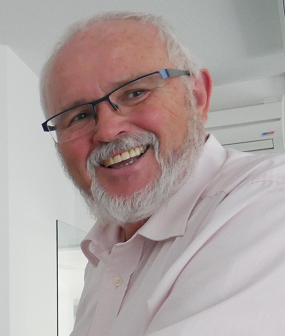5 September 2019
Interview with... Klaus Dieter Schutte, Key Account Manager Bundeswehr and NATO, DFS Aviation Services GmbH
Key Account Manager Bundeswehr and NATO, DFS Aviation Services GmbH
[Cleared n°7 - year XVI - jul_aug 2019]
Key Account Manager Bundeswehr and NATO, DFS Aviation Services GmbH
[Cleared n°7 - year XVI - jul_aug 2019]

DFS consolidated its 16 radar approach control (APP) units into its area control centres (ACC) many years ago. What APP units were involved, when did the consolidations take place and how many movements do the airports have today?
When the new corporatised DFS started in 1993, it was organised into five geographical regions (North, West, East, South and Central). Each of these was composed of one ACC (Region Central had two control centres: ACC Frankfurt + UAC Karlsruhe) and the assigned TWR/APP units.
The situation in these regions was not homogeneous, as some APPs were already co-located/integrated in a control centre, such as Bremen, while others were more than a hundred kilometres away from a control centre (Erfurt, Dresden, etc.). Besides that, military APP units were also being integrated into DFS.
|
Timeline |
|
|
1994/95 |
Integration of military radar APP units RAPCON Eiffel, Ramstein and Niederstetten into Frankfurt ACC |
|
1995/96 |
Integration of Dresden, Erfurt and Leipzig APP into ACC Berlin |
|
1995 |
Co-location of Stuttgart APP with Frankfurt APP. Later on, both units were integrated into Langen ACC |
|
1998/99 |
Integration of Hamburg and Hannover APP into Bremen ACC Integration of Nürnberg APP into Langen ACC, later on it was relocated to Munich ACC |
|
2000 |
Integration of Düsseldorf ACC (including APP functions for Düsseldorf, Cologne, Münster and other regional airports) into Langen ACC |
The integrated APP units cover the whole range of movements from 10,000 a year (Erfurt) to more than 500,000 a year (Frankfurt).
Why did DFS decide at that time to consolidate the APP units in its area control centres?
There was more than one reason for this. At the time, there were several innovation projects being carried out almost in parallel. The major points at issue were:
- DFS had to replace the ATS systems of its area control centres for lower airspace. To expedite this renewal programme, the decision was made to reduce the number of ACCs from five to three, so only three systems had to be replaced. The new P1 system was capable of being used in ACC and APP units.
- A replacement of tower infrastructure was necessary as well. In the past, tower buildings had been part of airport infrastructure and were built by the airports. For that reason, ATS systems had to be customised to the tower infrastructure of each airport. DFS decided to build its own, standardised tower buildings, allowing better harmonisation of ATM technology. These towers were planned as stand-alone towers without approach control.
- Discussions on a common Concept of Operations showed that integrating approach control units into ACCs could be beneficial as a way to optimise the interface between the two. In parallel, DFS decided to optimise training by splitting the initial training for ATCOs into tower and centre training.
What operational benefits did you experience in air traffic management with this approach to APP consolidation?
-
The integration of approach control into centre sectors / sector families optimised the airspace structure and reduced controller workload and coordination effort.
- Automated systems for coordination between TWR and APP/ACC were implemented to optimise these interfaces.
- Splitting ATCO training into tower and centre (including approach control) training courses reduced the duration of initial training at the DFS Academy.
What problems did you have in the process with personnel and unions?
- Units and members of the Staff Council were involved in the change management process from the very beginning.
- A catalogue of social criteria was put in place to take care of the situation of each individual ATCO / flight data specialist. Rankings were established between ATCOs remaining at the tower and those moving to a control centre.
- Moving allowances were paid.
How complex was the training for each APP unit?
This question is not easy to answer in one sentence as the integration took place in several steps:
- STEP 1 was to relocate the APP personnel to the control centre unit (co-location phase). The training effort mainly focussed on using the centre’s ATS system and handling the controller working position.
- STEP 2 involved the cross-training of ATCOs from the APP unit and the ATCOs from the adjacent/surrounding control centre sectors. At a DFS control centre, ATCO ratings are usually grouped into sector families along mainly geographical lines (for example, east sectors, west sectors, etc.). The DFS integration pursued the concept of allowing former APP controllers obtain ratings for the surrounding ACC sectors and vice versa.
- STEP 3 was an optimisation phase in some of the sector families (sector boundaries laterally and vertically) to reduce workload and coordination effort at sector boundaries.
Do you think the consolidated approach has been beneficial considering the expected dramatic increase in traffic in next ten years?
In the 25 years of DFS (1993 – 2018), air traffic movements in Germany have doubled. This shows that the integrated ACC/APP concept of DFS was able to cope with this demand and will be able to cope in the future.


